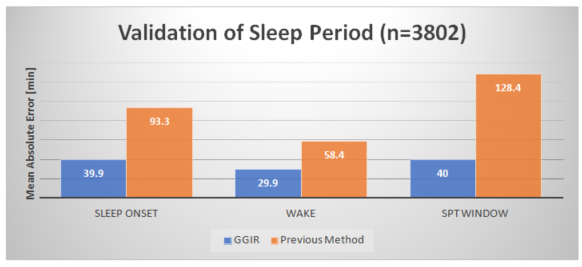Blog 5 - Verisense Algorithm Validation Studies
In Blog 5, we go into detail on how the algorithm Verisense uses to obtain activity and sleep metrics has been validated.
The Verisense platform utilizes the widely used GGIR algorithm to obtain long-term physical activity and sleep data from the raw sensor data. These algorithms were created by top academic researchers and have been validated to a very high level. GGIR algorithms have been used in large scale sleep and physical activity research on a wide range of patient populations for a number of years.
This blog summarizes the validation of the algorithms that are used in Verisense.
Physical Activity
A 2014 study found that data from a wrist sensor was generally quite accurate at detecting various physical activity levels [1]. Euclidean norm minus one values were calculated from the wrist sensor and a cut point approach was used to classify activities into sedentary, light physical activity (PA), moderate PA and vigorous PA. Classifications from the wrist sensor ENMO outputs were compared to metabolic equivalent of task (MET) values from the metabolic gas analysis system. Results are summarized below.
In addition the following paper further details the Physical Activity research undertaken with the GGIR algorithm since 2014. The number of studies undertaken, cohorts used and references are provided.
Sleep Period Time (SPT) Window Validation
Sleep onset time, waking time and sleep period time (SPT) window (time from sleep onset to waking) was validated in a 2018 paper [2] on the following populations:
50 patients recorded with polysomnography
752 patients recorded with sleep logs
Wake Detection after Sleep Onset
A method to detect wake periods after sleep onset was developed and validated on polysomnography data from 28 participants [3]. The following graph shows accuracy, sensitivity and specificity for sleep / wake classification compared to polysomnography results.
Notes
Accuracy = (correctly identified sleep or wake periods) / (all sleep or wake periods)
Sensitivity = (correctly identified sleep periods) / (all sleep periods)
Specificity = (correctly identified wake periods) / (all wake periods)
In addition the following paper provides a detailed summary on 14 published papers that used the GGIR algorithm for Sleep Research. Details on the populations studied, cohort and disease states are included with references.
The advantage of using Verisense along with these algorithms is that you have confidence that they have been used extensively on a wide range of patient groups and the algorithms are accessible, understandable and have been verified by top researchers in the field.
References
1. Hildebrand, M.V.H.V., VAN, V.H., Hansen, B.H. and Ekelund, U.L.F., 2014. Age group comparability of raw accelerometer output from wrist-and hip-worn monitors. Medicine and science in sports and exercise, 46(9), pp.1816-1824.
2. van Hees, V.T., Sabia, S., Jones, S.E., Wood, A.R., Anderson, K.N., Kivimäki, M., Frayling, T.M., Pack, A.I., Bucan, M., Trenell, M.I. and Mazzotti, D.R., 2018. Estimating sleep parameters using an accelerometer without sleep diary. Scientific reports, 8(1), p.12975.
3. Van Hees, V.T., Sabia, S., Anderson, K.N., Denton, S.J., Oliver, J., Catt, M., Abell, J.G., Kivimäki, M., Trenell, M.I. and Singh-Manoux, A., 2015. A novel, open access method to assess sleep duration using a wrist-worn accelerometer. PloS one, 10(11), p.e0142533.





